|
.
Open
Mic is a new feature that allows readers to contribute their own
articles. Click here for more information and guidelines on adding your
article to Coaster Kingdom.
This
month's article is by Phil Ariss from yeah7.com
Fairgrounds
historically have always been at the forefront of the amusement
industry, pushing the boundaries and putting on a show of magnificent
scale to draw customers and their wallets in.
Just
looking back over the last 30 years shows what incredible travelling
coasters and companies made their name by dominating the fairground.
Sadly,
this isn’t the case at this moment in time.
Most
reputable mid-sized fairs are likely to feature a roller coaster; sadly,
these days it’s most likely to be a Reverchon spinning mouse. With
Reverchon selling as many units as the Ford Focus, it’s a safe but
tragic bet.
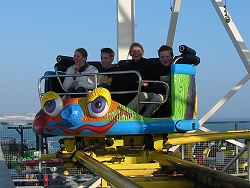 Gone
are the unique, custom designed, awe-inspiring coasters. These are
replaced by the Reverchon spinning coasters and like for like
alternatives. What market there is, is flooded with cheap, small to mid
size coasters, all carbon copies of each other. Gone
are the unique, custom designed, awe-inspiring coasters. These are
replaced by the Reverchon spinning coasters and like for like
alternatives. What market there is, is flooded with cheap, small to mid
size coasters, all carbon copies of each other.
As
a coaster itself, Reverchon did (begrudgingly) amazingly well. The
amount of units sold is beyond belief; they even managed to sell two to
Disney! They are quite simply, everywhere. Last summer, one Reverchon
spinning coaster was sitting in the shadow of Eurostar at Hamburg during
the Sommerdom, a perfect picture of rides at opposite ends of the scale,
a stark contrast in every respect.
The
success of Reverchon and its spinning coasters isn’t hard to see, they
do give a good ride that appeals to everyone, the ride is of
considerable length, the spinning of the cars is always different each
time and great fun.
Better
still and more importantly, the ride is cheap and easy to transport with
only five trailers plus a crane needed, compare this with a Mondial
Topscan which requires three trailers and a crane, the potential for
revenue is far greater.
Travelling
roller coasters are in a recession at the moment, without a new
headliner since 1995 when Bruch gave Eurostar its debut. Since then, the
above mentioned spinning mouse has caught on faster than a plaque in
every sense of the word, leaving most fairs without a centrepiece
attraction fairs desperately need.
Realistically,
there are few places on Earth that could sustain giant travelling
coasters on the scale of Eurostar. Understandably, giants of this scale
are all custom built. However, I’m sure there are many countries that
could sustain better quality, mid-sized coasters, the UK being one.
Any
park in the world is quite literally, spoilt for choice. The massive
choice of vendors and their products seem endless, but this choice
isn’t there for showman anymore. Whether this lack of choice is down
to the lack of interest from showman, or simply the lack of sales to
push development for the vendor, it’s sad to see so few companies
offering their products to showman.
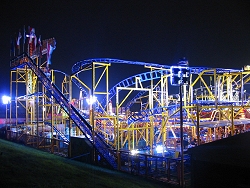 MACK
and Maurer Söhne are the only reputable companies that have been
offering and selling their products, but nothing more creative than a
slight advancement of the Wild Mouse concept. Maurer Söhne sold three
units of their Xtended SC 2000 design named Cyberspace, Extrem and
Spinning Racers between 2000 and 2001. MACK
and Maurer Söhne are the only reputable companies that have been
offering and selling their products, but nothing more creative than a
slight advancement of the Wild Mouse concept. Maurer Söhne sold three
units of their Xtended SC 2000 design named Cyberspace, Extrem and
Spinning Racers between 2000 and 2001.
However
the first two have since found their home at Camelot and Drievliet
respectively and no longer travel and haven’t sold another unit since.
The
lack of a new, exciting mid-sized coaster is a concern, there seems to
be nothing to fill the void between the entry level clone and giant
masterpiece. The only glimmer of light in a dark tunnel could be
Gerstlauer, who with their Euro Fighter design could see some units
being sold. “Typhoon” (Bobbejaanland,
Belgium) has been built with a base frame, which is encouraging.
The
ride was pre-built for testing at the Gerstlauer factory before being
shipped to Bobbejaanland, so the potential for this ride model to travel
is there. It has the right credentials too with it being compact, has an
excellent throughput and offering a superb ride experience while being
novel with it’s beyond vertical drop to insanely intense vertical
loop. It could be a headliner, given the chance.
Like most well designed products, there are always going to be cheaper
copies available from other vendors. SBF Visa Group filled this void and
was quick to beat Gerstlauer to their own design. “Cool & Fresh”
can be seen doing the rounds in mid sized European fairs. Very basic in
design, it features a vertical lift, with a beyond vertical drop into a
vertical loop.
Such
is the bad design that the ride is killed by brakes down the drop and
before the loop, killing all the speed that it craws back to the station
and wastes the height of the lift. Without these brakes the ride would
simply be too fast and violent through the vertical loop.
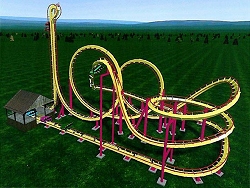 With
only the capability to load and unload one car at a time and production
looking exceptionally cheap, “Cool & Fresh” was never going to
set the world alight. While SBF Visa showed plans for a longer version,
whether any showman is brave enough to buy it remains to be seen. With
only the capability to load and unload one car at a time and production
looking exceptionally cheap, “Cool & Fresh” was never going to
set the world alight. While SBF Visa showed plans for a longer version,
whether any showman is brave enough to buy it remains to be seen.
Another
potential ride for the future could well be Maurer Söhne and their
X-Car design. While there has been nothing to suggest a travelling
model, it does have the raw ingredients that could prove it to be a hit.
The compact nature of travelling rides could really mean some
interesting designs utilising the prolonged inverted position that each
of their rides have to date.
What
the future holds for travelling coasters remains to be seen, one thing
we can say with assurance is that if they are held in as high regard as
the coasters currently travelling in Germany, then we will be very
lucky. In Germany, we not only find travelling coasters of the highest
grade, we find variety. This is where things get a little bit more
exciting.
Held
in the highest regard, without a doubt, is Rudolf Barth’s “Olympia
Looping”. Making its debut in 1989, it was one of the last projects to
carry the Schwarzkopf name. The sheer scale of this ride has to be seen
to be believed, it’s quite simply mammoth. No photos or videos really
give any justice to how big this ride is, or what a fantastic piece of
engineering it is. It dwarfs anything near by and will always be the
centrepiece of any fair it graces, a true headline act.
The
nature of travelling coasters requires a compact layout. On one hand,
it’s hardly compact with a footprint measuring 85 by 36 metres, on the
other hand, its more than compact fitting in a total track length of
1250 metres! To put that into perspective, Nemesis weighs in at a mere
715 metres.
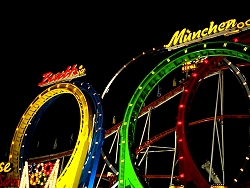 With
such a long track length, Olympia Looping has two lift hills, both tyre
driven. The first is a curved lift-hill from the station to the rides
peak, a mere 33 metres. In typical Schwarzkopf fashion, the main lift
rises to the back giving the perfect backdrop, allowing spectators to
see the whole layout in all its glory. The second lift sits below the
main lift; running in the opposite direction and has the added function
of being a block segment. This lift matches the incoming speed of a
train perfectly, without a noticeable decrease in speed; the flow of the
ride isn’t affected at all and the train swiftly departs the block and
continues the mayhem. With
such a long track length, Olympia Looping has two lift hills, both tyre
driven. The first is a curved lift-hill from the station to the rides
peak, a mere 33 metres. In typical Schwarzkopf fashion, the main lift
rises to the back giving the perfect backdrop, allowing spectators to
see the whole layout in all its glory. The second lift sits below the
main lift; running in the opposite direction and has the added function
of being a block segment. This lift matches the incoming speed of a
train perfectly, without a noticeable decrease in speed; the flow of the
ride isn’t affected at all and the train swiftly departs the block and
continues the mayhem.
From
start to finish, Olympia Looping never lets up. The train navigates the
course with such speed it’s easily one of the most intense coasters
out there, pulling in excess of 5g on the loops. Considering the ride is
now in its 17th year, it’s impeccable for its age. The track work is
near perfect, roughness just isn’t a question for this coaster like
most other rides its age.
Its
presentation is immaculate, the sense of occasion and magnitude is so
apparent that it is worthy of the Olympia name and Olympic rings it
bares. It’s an incredibly versatile ride, with the ability to run
between 1 and 5 trains, and the train length can range from 5 to 7 cars,
its throughput is simply unrivalled and can top out at about 3000 an
hour. Olympia Looping is as near to perfection as a travelling coaster
can get.
Olympia
Looping shares its limelight with two other giants that travel
throughout Germany. These being another Schwarzkopf classic, the 1983
Alpina Bahn and the 1995 Intamin/Giovanola creation of Eurostar.
Alpina
Bahn stands alone in that it’s a non-inverting coaster, more of a
“family coaster” if there ever was such a genre. It was the first of
the great travelling Schwarzkopf giants and came before the classics Dreier
Looping and Thriller. Like Olympia Looping, its age is merely a number;
having been lovingly cared for by its owners, Bruch.
It
rides like a dream, offering airtime, positive and lateral forces, head
choppers and speed in abundance, all the ingredients that make this an
incredible coaster.
The
front is dominated by a large airtime hill that sits above the themed
frontage and cash desks, with animatronics, flowers and other decorative
props to this amazing show. This is a coaster that comes alive at night
with its full compliment of trains running; there are few places that
can match the atmosphere that Alpina Bahn on a packed ground.
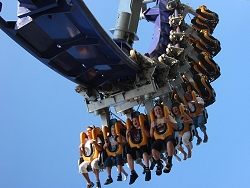 Eurostar
is probably the most remarkable of the three, due to its amazing
conception, design process and the sheer amount of companies involved in
brining the ride to reality. When it opened in 1995 it was the first
transportable inverted coaster, opening just three years after B&M
debuted their design. Eurostar
is probably the most remarkable of the three, due to its amazing
conception, design process and the sheer amount of companies involved in
brining the ride to reality. When it opened in 1995 it was the first
transportable inverted coaster, opening just three years after B&M
debuted their design.
Unlike
Schwarzkopf coasters, Eurostar’s components are much larger. The
track, trains, supports and base frame are all considerably larger. It
takes a single trailer to transport just one of the four trains on a
section of station track.
Consider
that as mentioned above, a Reverchon spinning coaster travels on five
trailers in its entirety, to transport Eurostar is a remarkable feat of
engineering and logistics and is truly a credit to Bruch and their
ability to manage such an on-going project as large as this, not to
mention the transport of Alpina Bahn, Spinning Racers and a Huss
Breakdance.
Like
Olympia Looping, Eurostar is built with throughput in mind and at its
peak, with its compliment of all four trains running, will hit just
under 3000 and hour, that’s a train leaving the station, full, nearly
every 30 seconds.
Lastly,
we have Starworld. A transportable indoor coaster, laden with special
effects and animatronics. With its futuristic theme, it’s another
coaster that dominates the area around it, with everyone’s focus being
drawn in by the ludicrously large animatronic robot.
Beckoning
passers by to enter the ride, the wonderful robot speaks and makes
gestures, all with moving limbs of course. With speakers tactfully
hidden in his kneecaps, and flaming torch in hand, its hard not to be
wowed by this incredible spectacle. Every so often, this gentle giant
slows down to a stop and another animatronic figure speaks up, this time
a light sabre wielding, dark figure by the cash desks challenges us to
enter.
The
ride itself is a self built spinning coaster similar to those Maurer
Söhne spinning coasters with trains found at parks like Drievliet.
Inside, the ride is pretty dark, with English commentary preparing
riders to blast off into space. The darkness is broken up with a
fantastic laser light that cuts across the building and a fire affect
towards the end of the ride, which engulfs the final helix with fire and
heat to give the riders the perfect send off before re-entering the
station.
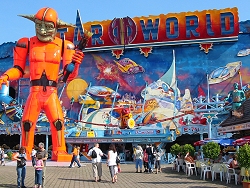 Each
of these coasters is custom designed and built, offer something
different and unique to one another and are undoubtedly a success in
their own right and a credit to their owners. But what makes these
coasters even more special is that unlike park operated coasters, they
do and must hit the theoretical throughput. Each
of these coasters is custom designed and built, offer something
different and unique to one another and are undoubtedly a success in
their own right and a credit to their owners. But what makes these
coasters even more special is that unlike park operated coasters, they
do and must hit the theoretical throughput.
It
would be a miracle at a park to see a B&M coaster reach its optimal
1400 an hour, but at a fair, time is money and everything is done to
make sure these coasters hit their mark. If that means a member of staff
is on each row and closes your restraint for you, then so be it, there
will be no delay in dispatching the train.
It’s
been over 10 years since we’ve had a new headline act, let’s hope
that when it does arrive it can achieve the same level of respect that
previous headline acts command and deserve. Fingers crossed.
Guest
Author: Phil
Ariss
|